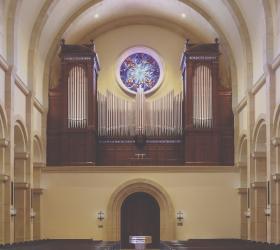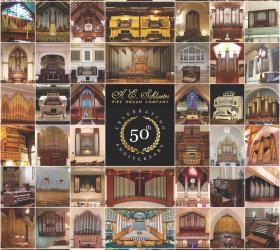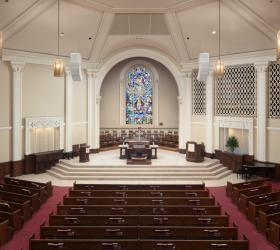
Petty-Madden Organbuilders, Hopewell, New Jersey, Op. 53
Dobbs Chapel at Trinity Presbyterian Church, Atlanta, Georgia
Petty-Madden has installed its second organ at Trinity Presbyterian Church, Atlanta. The first, a large three-manual electro-pneumatic instrument built in the 1980s, is located in the church’s primary worship space. The second instrument was commissioned for the recently completed Dobbs Chapel at Trinity.
The new mechanical-action organ for Dobbs Chapel is contained within a case of painted and stained hardwoods. In order to fulfill the church design team’s vision of an organ with minimal visual intrusion into the chancel, the organ case is unusually deep—eighteen feet to be exact—with the Swell division located behind the Great and Pedal. Since most of the organ is tucked behind a false wall, its physical massiveness is not apparent to the eye.
Planning, designing and producing an organ typically present new challenges for the organbuilder. Throughout the entire project, mutual trust and respect proved to be the coin of the realm, making working conditions exceedingly pleasant and rewarding. The quality of talent and cooperation gathered around the conference table produced extraordinary results. The chapel architecture is lavishly elegant in its simplicity; the acoustics—even for a space that seats less than 200—are as good as it gets; and the organ is ideally suited—both visually and aurally—for its home.
The quality of ingredients in large part determines the quality of the finished product. Petty-Madden has long maintained and demonstrated that lead is a noble metal and that the popularity of organ pipes made with high tin content is based more on myth and misconception than common sense. All principal pipework, including the polished façade, and open flutes are made from an alloy that is 60% lead and 40% tin. The quantity of lead is further increased to 75% in the stopped flutes and the Pedal Posaune. Of the flue pipes, only the Viola and Viola Celeste are made predominantly of tin. The principal chorus is at the same time bold yet gentle; there is a certain vocal breathiness in the speech of the flue pipes; the reeds are colorful, quick and consistent in attack and timbre; the ensembles are tight and cohesive, and the tonal style eclectic.
An organ should work as beautifully as it sounds, too. The mechanical key-action is light and responsive, inasmuch as a smooth, sensitive tracker action was a “given” from the outset of the design process. Instead of traditional wood, inert carbon fiber rods are used for the trackers and the hornbeam tracker squares are fitted with virtually frictionless acetal bearings, which ride on stainless steel axles. The wind chest pallets and key channels are designed for optimum wind supply to the pipes and minimum “pluck.” Pneumatic tremulant controls are located outside the organ case in the blower room; thus, the tremulants are silent. The wind system for the organ is also silent. The wind trunks are constructed of birch and have multiple-cut miters to minimize wind turbulence. Of particular interest is the construction and location of the Swell division. Positioned low in the rear of the case, the Swell must speak through the Great, thereby creating a remarkable cohesion with the latter. Second, the thick walls and shutters of the Swell contain a dead air space sandwiched between the inner and outer wooden surfaces; all of this results in an extraordinary expression rarely found in most organs. Indeed, with the shutters closed, “full Swell” can only be heard faintly when coupled to the Great foundation stops. A gradual pressure of the foot on the expression pedal unleashes a dramatic crescendo worthy of any romantic literature ever written.
Finally, the organ case is totally integrated with the elegant and simple architecture of the chapel. Graceful Ionic columns on elevated pedestals support the entablature under the pedal towers, pipes of the Great Principal in the center flat frame the window behind the organ, and the raised panels of the case mirror those found in the chapel wainscoting. The recessed console is constructed of quarter-sawn red oak and the pipe screens in the pedal towers are bundles of metal cylinders held together with hand-carved wooden ribbons.
—Bynum Petty
GREAT (Manual I)
8’ Principal
8’ Chimney Flute
4’ Octave
4’ Hohl Flute
2’ Block Flute
22⁄3 Sesquialtera II
2’ Mixture IV
8’ Trumpet
Tremulant
Swell to Great
SWELL (Manual II)
8’ Viola
8’ Viola Celeste
8’ Stopped Flute
4’ Principal
4’ Koppel Flute
2’ Octave
1’ Mixture IV
8’ Trumpet
8’ Oboe
Tremulant
PEDAL
16’ Subbass
8’ Principal Bass
8’ Gedackt Bass
4’ Choral Bass
16’ Posaune
Great to Pedal
Swell to Pedal
Mechanical key action
Electric stop action
8-level combination action
8 general combinations
4 divisional combinations per division
61-note manual compass
32-note pedal compass
Manual keys of laminated construction with polished bone covers
on the natural keys and polished ebony on the sharps
Pedal keys made of maple; sharps capped with African blackwood
70 mm (± 2.75”) wind pressure throughout




